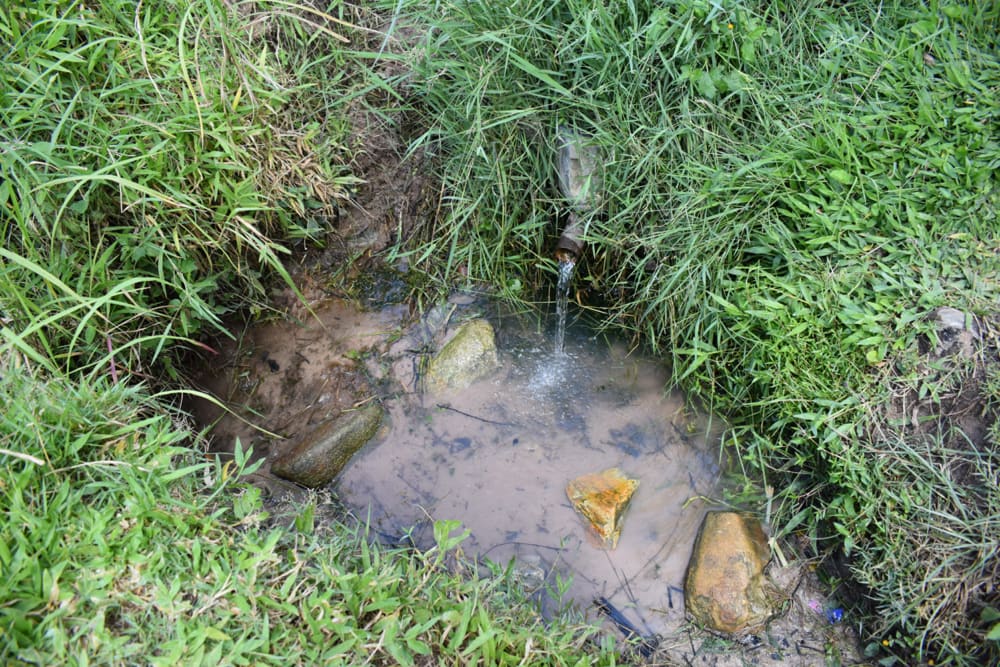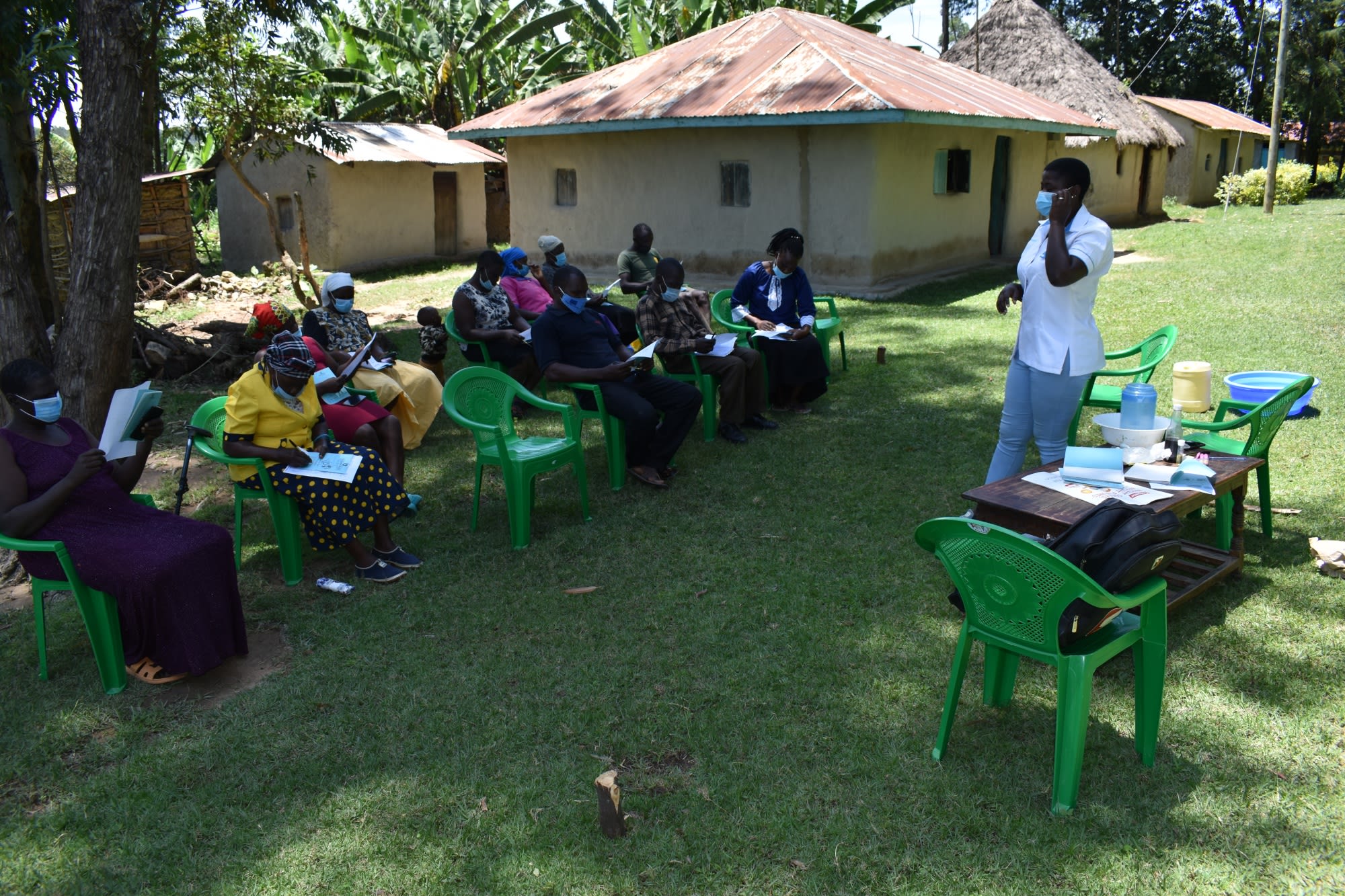"The main problem I experience is fetching this water, especially during rainy seasons like now. There is mud everywhere and that makes it difficult to get to the water. Also, it becomes so dirty that when you carry it home, you need to treat [the water] before using it for drinking," said Levi, a teenager who lives in Mukangu and depends on Mukasia Spring for water.
Mukasia Spring serves 84 people in this community, but in its unprotected state it cannot provide clean water. The spring looks like a small puddle carved into the surrounding grass, with a muddy and rocky bottom. To try to ease the process of fetching water, community members have tried to secure a bottle lodged directly into the grass. The bottle helps to catch some of the spring's discharge and forces it to flow through the bottleneck.

But there is still so much water flowing around the bottle that the discharge is not as high as it could be. This, combined with the tricky and small access point, makes drawing water slow for each person who comes to the spring.
The spring's water is unsafe to drink, which is why Levi reported they try to treat it before drinking it. Animals often drink straight from the source, and the water carries toxins from farm chemicals, soil, and animal waste brought in with surface runoff from the rains.
But all treatment methods, whether they are purchased at the market or done at home by boiling, have a cost that not all families can cover at all times. This means the spring water often gets consumed untreated, leading to water-related illnesses. Community members report that the main health consequences after consuming untreated water from Mukasia Spring include diarrhea, typhoid, and stomachaches. Children are the main ones affected by these illnesses, the adults said, especially during rainy season when the rate of typhoid rises.
"Personally, I have been affected health-wise. My children get water from the spring and they do not take precautions. When the water is dirty, they bring it that way and this makes it unfit for my health. This landed me in hospital and upon testing, it was diagnosed to be typhoid which is due to unhygienic environment and handling of the water. I believe if there is any help, then I will be the happiest person to receive blessings," said Rose Wafula, a 32-year-old farmer in the community.
Other than health effects, the other problem community members report as a result of depending on Mukasia Spring is a drop in their income. This is because the resources to be used to invest in their businesses and farmwork must often be diverted to seeking medication for their water-reated diseases. They also lose time at their jobs, at home, and at school, hurting everyone's chances to reach their full potential.
What We Can Do:
Spring Protection
Protecting the spring will help provide access to cleaner and safer water and reduce the time people have to spend to fetch it. Construction will keep surface runoff and other contaminants out of the water. With the community’s high involvement in the process, there should be a good sense of responsibility and ownership for the new clean water source.
Fetching water is a task predominantly carried out by women and young girls. Protecting the spring and offering training and support will, therefore, help empower the female members of the community by freeing up more of their time and energy to engage and invest in income-generating activities and their education.
Training on Health, Hygiene, COVID-19, and More
To hold trainings during the pandemic, we work closely with both community leaders and the local government to approve small groups to attend training. We ask community leaders to invite a select yet representative group of people to attend training who will then act as ambassadors to the rest of the community to share what they learn. We also communicate our expectations of physical distancing and wearing masks for all who choose to attend.
The training will focus on improved hygiene, health, and sanitation habits in this community. We will also have a dedicated session on COVID-19 symptoms, transmission routes, and prevention best practices.
With the community’s input, we will identify key leverage points where they can alter their practices at the personal, household, and community levels to affect change. This training will help to ensure participants have the knowledge they need about healthy practices and their importance to make the most of their water point as soon as water is flowing.
Our team of facilitators will use a variety of methods to train community members. Some of these methods include participatory hygiene and sanitation transformation, asset-based community development, group discussions, handouts, and demonstrations at the spring.
One of the most important issues we plan to cover is the handling, storage, and treatment of water. Having a clean water source will be extremely helpful, but it is useless if water gets contaminated by the time it is consumed. We and the community strongly believe that all of these components will work together to improve living standards here, which will help to unlock the potential for these community members to live better, healthier lives.
We will then conduct a small series of follow-up trainings before transitioning to our regularly scheduled support visits throughout the year.
Training will result in the formation of a water user committee, elected by their peers, that will oversee the operations and maintenance of the spring. The committee will enforce proper behavior around the spring and delegate tasks that will help preserve the site, such as building a fence and digging proper drainage channels. The fence will keep out destructive animals and unwanted waste, and the drainage will keep the area’s mosquito population at a minimum.

 Protected Spring
Protected Spring
 Rehabilitation Project
Rehabilitation Project



































